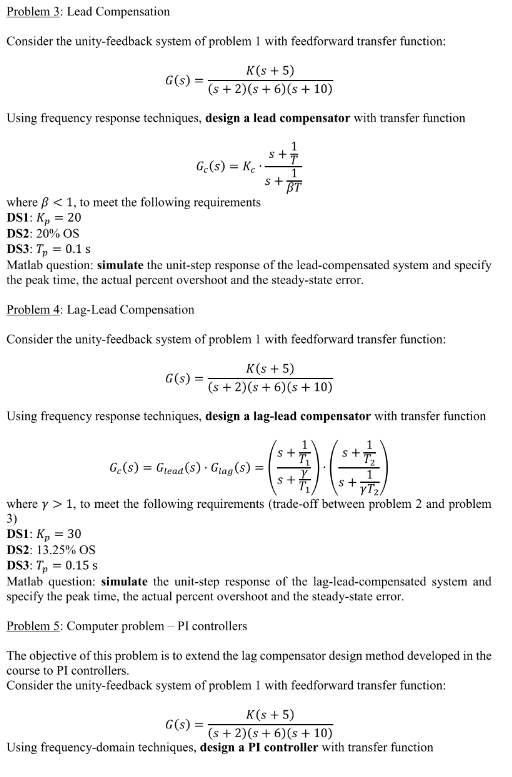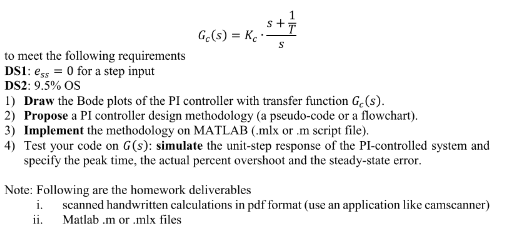


Problem 1: Gain Adjustment Consider the unity-feedback system with feedforward transfer function: K(s+5) G(s) = (5+2)(+6)(s + 10) Using frequency response techniques, adjust the preamplifier gain K to yield 9.5% OS in the unit-step response. Iterate if necessary by increasing the required phase margin to compensate for the effect of the third pole. What is the value of the static error constant Kı? Problem 2: Lag Compensation Consider the unity-feedback system of problem 1 with feedforward transfer function: K(s +5) G(s) (s + 2)(s +6) (s +10) Using frequency response techniques, design a lag compensator with transfer function S + Ge(s) = Kc S + aT where a > 1, to meet the following requirements DS1: Ky = 40 DS2: 9.5% OS In your design, add 3 to the required phase margin in order to compensate for the phase lag contributed by the lag compensator. MATLAB question: simulate the unit-step response of the lag-compensated system and specify the peak time, the actual percent overshoot and the steady-state error.
Problem 3: Lead Compensation Consider the unity-feedback system of problem 1 with feedforward transfer function: K(s+5) G() (s + 2)(8 + 6) (s +10) Using frequency response techniques, design a lead compensator with transfer function s+T Ge(s) = Kc S + BT where ß < 1, to meet the following requirements DS1: Ky = 20 DS2: 20% OS DS3: Tp = 0.1s Matlab question: simulate the unit-step response of the lead-compensated system and specify the peak time, the actual percent overshoot and the steady-state error. Problem 4: Lag-Lead Compensation Consider the unity-feedback system of problem 1 with feedforward transfer function: K(s + 5) G() (s + 2)(8 + 6) (s + 10) Using frequency response techniques, design a lag-lead compensator with transfer function S+ s+ TL Ge(s) = Glead(s). Gag(s) S+ S + where y > 1, to meet the following requirements (trade-off between problem 2 and problem 3) DS1: Ky = 30 DS2: 13.25% OS DS3: Tp = 0.15 s Matlab question: simulate the unit-step response of the lag-lead-compensated system and specify the peak time, the actual percent overshoot and the steady-state error. Problem 5: Computer problem - PI controllers The objective of this problem is to extend the lag compensator design method developed in the course to PI controllers. Consider the unity-feedback system of problem 1 with feedforward transfer function: K(s +5) G(s) = (s + 2)(s +6)(8 +10) Using frequency-domain techniques, design a PI controller with transfer function
1 S + S Ge(s) = Kc to meet the following requirements DS1: es= 0 for a step input DS2: 9.5% OS 1) Draw the Bode plots of the PI controller with transfer function Gc(s). 2) Propose a PI controller design methodology (a pseudo-code or a flowchart). 3) Implement the methodology on MATLAB (mlx or .m script file), 4) Test your code on G(s): simulate the unit-step response of the PI-controlled system and specify the peak time, the actual percent overshoot and the steady-state error. Note: Following are the homework deliverables i. scanned handwritten calculations in pdf format (use an application like camscanner) ii. Matlab .mor.mlx files
没有找到相关结果